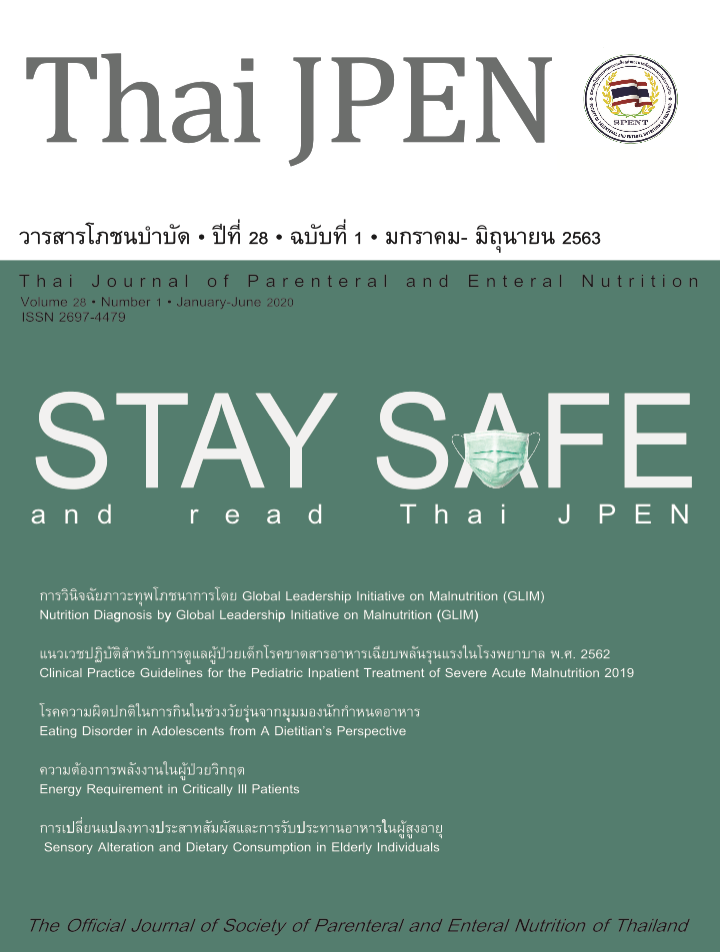การเปลี่ยนแปลงทางประสาทสัมผัสและการรับประทานอาหารในผู้สูงอายุ
คำสำคัญ:
โภชนาการ, การรับประทานอาหาร, ความอยากอาหาร, ประสาทสัมผัส, ภาวะสูงอายุ, ผู้สูงอายุบทคัดย่อ
อาหารมีความสำคัญต่อสุขภาพร่างกายของมนุษย์ทุกวัย การรับประทานอาหารให้เพียงพอและเหมาะสมกับความต้องการของร่างกายในแต่ละช่วงอายุจึงเป็นสิ่งจำเป็น อย่างไรก็ตามมีปัจจัยหลายด้านที่เกี่ยวข้องกับการรับประทานอาหารที่เปลี่ยนแปลงไป และทำให้เกิดภาวะทุพโภชนการตามมา ซึ่งปัจจัยที่สำคัญอย่างหนึ่งคือ การเปลี่ยนแปลงของระบบการรับความรู้สึก
การรับรู้ทางประสาทสัมผัสสัมผัสของอาหารเป็นปัจจัยสำคัญที่ทำให้เกิดความรู้สึกอยากและพอใจในอาหาร การรับรู้คุณสมบัติเหล่านี้ทำให้เกิดการรับรู้ การแปลผล และความรู้สึกต่ออาหารแต่ละชนิด โดยอาศัยระบบประสาทสัมผัส อันได้แก่ ระบบการมองเห็น ระบบการดมกลิ่น ระบบการรับรส ระบบการรับความรู้สึกทางกาย และระบบการได้ยิน และส่งผลต่อปริมาณและคุณภาพของอาหารที่รับประทานอาหาร ในผู้สูงอายุการรับรู้รสสัมผัสของอาหารนั้นเปลี่ยนแปลงไปจากเดิมโดยมีสาเหตุที่สำคัญ ได้แก่ ความชรา ความเจ็บป่วย ภาวะทุพโภชนาการ โรคประจำตัว และผลข้างเคียงจากการรักษา รสสัมผัสที่เปลี่ยนแปลงไปนี้ทำให้ผู้สูงอายุรับประทานอาหารเปลี่ยนแปลงไปด้วย และยังส่งผลให้ผู้สูงอายุมีความเสี่ยงต่อภาวะทุพโภชนาการเพิ่มขึ้น
ความเข้าใจการเปลี่ยนแปลงของระบบการรับรู้ความรู้สึกในผู้สูงอายุ และการดูแลทางโภชนาการ เพื่อปรับเปลี่ยนรูปแบบอาหารและสภาพแวดล้อมให้เอื้อต่อการเจริญอาหารของผู้สูงอายุ ส่งผลให้ผู้สูงอายุสามารถรับประทานอาหารได้อย่างเหมาะสม และช่วยป้องกันการเกิดโรคและภาวะทุพโภชนาการในผู้สูงอายุอีกด้วย
เอกสารอ้างอิง
Renner B, Sproesser G, Stok FM, Schupp H. Eating in the dark: a dissociation between perceived and actual food consumption. Food Qual Prefer 2016;50:145–51.
Donini LM, Savina C, Cannella C. Eating habits and appetite control in the elderly: the anorexia of aging. Int Psychogeriatr 2003;15:73-87.
Carabellese C, Appollonio I, Rozzini R, Bianchetti A, Frisoni GB, Frattola L, et al. Sensory impairment and quality of life in a community elderly population. J Am Geriatr Soc 1993;41:401-7.
Hall JE. Guyton and Hall Textbook of Medical Physiology. 13th ed. Philadelphia: Elsevier Health Sciences; 2015.
Piqueras-Fiszman B, Spence C. Colour, pleasantness, and consumption behaviour within a meal. Appetite 2014;75:165-72.
Peng M. How does plate size affect estimated satiation and intake for individuals in normal-weight and overweight groups?. Obes Sci Pract 2017;3:282-8.
English L, Lasschuijt M, Keller KL. Mechanisms of the portion size effect. What is known and where do we go from here?. Appetite 2015;88:39-49.
Burger KS, Fisher JO, Johnson SL. Mechanisms behind the portion size effect: visibility and bite size. Obesity 2011;19:546-51.
de Wijk RA, Zijlstra SM. Differential effects of exposure to ambient vanilla and citrus aromas on mood, arousal and food choice. Flavour 2012;1:24.
Ferriday D, Brunstrom JM. 'I just can't help myself': effects of food-cue exposure in overweight and lean individuals. Int J Obes 2011;35:142-9.
Tetley A, Brunstrom J, Griffiths P. Individual differences in food-cue reactivity. The role of BMI and everyday portion-size selections. Appetite 2009;52:614-20.
Gaillet-Torrent M, Sulmont-Rosse C, Issanchou S, Chabanet C, Chambaron S. Impact of a non-attentively perceived odour on subsequent food choices. Appetite 2014;76:17-22.
Chambaron S, Chisin Q, Chabanet C, Issanchou S, Brand G. Impact of olfactory and auditory priming on the attraction to foods with high energy density. Appetite 2015;95:74-80.
Gaillet M, Sulmont-Rossé C, Issanchou S, Chabanet C, Chambaron S. Priming effects of an olfactory food cue on subsequent food-related behaviour. Food Qual Prefer 2013;30:274-81.
Li J, Lemon CH. Influence of stimulus and oral adaptation temperature on gustatory responses in central taste-sensitive neurons. J neurophysiol 2015;113:2700-12.
Green BG, Nachtigal D. Temperature affects human sweet taste via at least two mechanisms. Chem Senses 2015;40:391-9.
Bolhuis DP, Forde CG, Cheng Y, Xu H, Martin N, de Graaf C. Slow food: sustained impact of harder foods on the reduction in energy intake over the course of the day. PLoS One. 2014;9:e93370.
Endo H, Ino S, Fujisaki W. The effect of a crunchy pseudo-chewing sound on perceived texture of softened foods. Physiol Behav 2016;167:324-31.
Mayor Poupis L. Wishful hearing: The effect of chronic dieting on auditory perceptual biases and eating behavior. Appetite 2018;130:219-27.
Fiegel A, Meullenet JF, Harrington RJ, Humble R, Seo HS. Background music genre can modulate flavor pleasantness and overall impression of food stimuli. Appetite 2014;76:144-52.
Crisinel A-S, Cosser S, King S, Jones R, Petrie J, Spence C. A bittersweet symphony: Systematically modulating the taste of food by changing the sonic properties of the soundtrack playing in the background. Food Qual Prefer 2012;24:201-4.
Milliman RE. The influence of background music on the behavior of restaurant patrons. J Consumer Research 1986;13:286-9.
Abdel-Aal el SM, Akhtar H, Zaheer K, Ali R. Dietary sources of lutein and zeaxanthin carotenoids and their role in eye health. Nutrients 2013;5:1169-85.
Liu R, Wang T, Zhang B, Qin L, Wu C, Li Q, et al. Lutein and zeaxanthin supplementation and association with visual function in age-related macular degeneration. Invest Ophthalmol Vis Sci 2014;56:252-8.
Hadley K, Orlandi RR, Fong KJ. Basic anatomy and physiology of olfaction and taste. Otolaryngol Clin North Am 2004;37:1115-26.
Sergi G, Bano G, Pizzato S, Veronese N, Manzato E. Taste loss in the elderly: possible implications for dietary habits. Crit Rev Food Sci Nutr. 2017;57:3684-9.
Weenen H, Jellema RH, de Wijk RA. Sensory sub-attributes of creamy mouthfeel in commercial mayonnaises, custard desserts and sauces. Food Qual Prefer 2005;16:163-70.
ดาวน์โหลด
เผยแพร่แล้ว
รูปแบบการอ้างอิง
ฉบับ
ประเภทบทความ
สัญญาอนุญาต
เนื้อหาและข้อมูลในบทความที่ตีพิมพ์ลงใน Thai JPEN วารสารโภชนบำบัด ถือเป็นข้อคิดเห็นและความรับผิดชอบของผู้เขียนบทความโดยตรงซึ่งกองบรรณาธิการวารสารไม่จำเป็นต้องเห็นด้วยหรือร่วมรับผิดชอบใด ๆ
บทความ ข้อมูล เนื้อหา รูปภาพ ฯลฯ ที่ได้รับการตีพิมพ์ใน Thai JPEN วารสารโภชนบำบัด ถือเป็นลิขสิทธิ์ของ Thai JPEN วารสารโภชนบำบัด หากบุคคลหรืหน่วยงานใดต้องการนำทั้งหมดหรือส่วนใดส่วนหนึ่งไปเผยแพร่หรือเพื่อกระทำการใด จะต้องได้รับอนุญาตเป็นลายลักษณ์อักษรจาก Thai JPEN วารสารโภชนบำบัด ก่อนเท่านั้น



